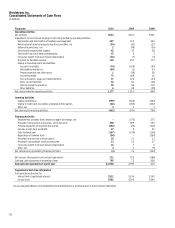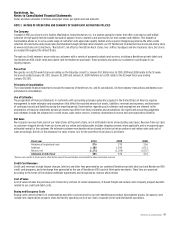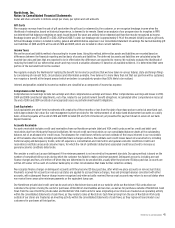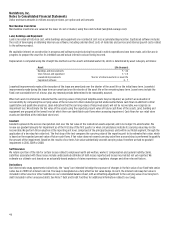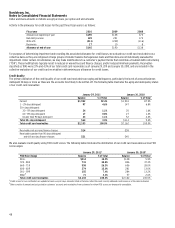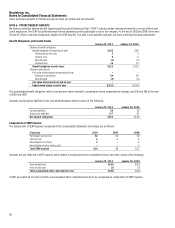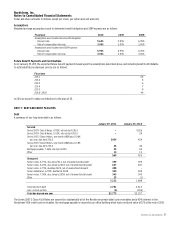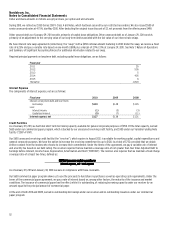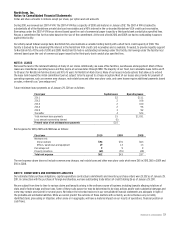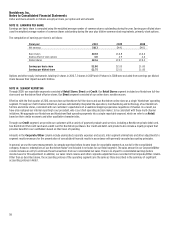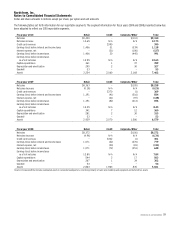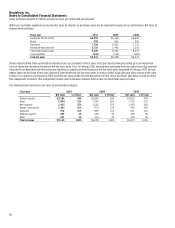Nordstrom 2010 Annual Report Download - page 60
Download and view the complete annual report
Please find page 60 of the 2010 Nordstrom annual report below. You can navigate through the pages in the report by either clicking on the pages listed below, or by using the keyword search tool below to find specific information within the annual report.
52
Nordstrom, Inc.
Notes to Consolidated Financial Statements
Dollar and share amounts in millions except per share, per option and unit amounts
During 2010, we retired our $350 Series 2007-1 Class A & B Notes, which had been secured by our restricted receivables. We also issued $500 of
senior unsecured notes at 4.75%, due May 2020. After deducting the original issue discount of $2, net proceeds from the offering were $498.
Other secured debt as of January 29, 2011 consists primarily of capital lease obligations. Other unsecured debt as of January 29, 2011 consists
primarily of an adjustment to the carrying value of our long-term debt associated with the fair value of our interest rate swaps.
We have interest rate swap agreements (collectively, the “swap”) with a $650 notional amount maturing in 2018. Under the swap, we receive a fixed
rate of 6.25% and pay a variable rate based on one-month LIBOR plus a margin of 2.9% (3.1% at January 29, 2011). See Note 1: Nature of Operations
and Summary of Significant Accounting Policies for additional information related to our swap.
Required principal payments on long-term debt, excluding capital lease obligations, are as follows:
Fiscal year
2011 $5
2012 505
2013 5
2014 405
2015 6
Thereafter 1,820
Interest Expense
The components of interest expense, net are as follows:
Fiscal year 2010 2009 2008
Interest on long-term debt and short-term
borrowings $133 $148 $145
Less:
Interest income (1) (3) (3)
Capitalized interest (5) (7) (11)
Interest expense, net $127 $138 $131
Credit Facilities
As of January 29, 2011, we had total short-term borrowing capacity available for general corporate purposes of $950. Of the total capacity, we had
$650 under our commercial paper program, which is backed by our unsecured revolving credit facility, and $300 under our Variable Funding Note
facility (“2007-A VFN”).
Our $650 unsecured revolving credit facility (the “revolver”), which expires in August 2012, is available for working capital, capital expenditures and
general corporate purposes. We have the option to increase the revolving commitment by up to $100, to a total of $750, provided that we obtain
written consent from the lenders who choose to increase their commitment. Under the terms of the agreement, we pay a variable rate of interest
and a facility fee based on our debt rating. The revolver requires that we maintain a leverage ratio of not greater than four times Adjusted Debt to
Earnings before Interest, Income Taxes, Depreciation, Amortization and Rent (“EBITDAR”). The revolver also requires that we maintain a fixed charge
coverage ratio of at least two times, defined as:
EBITDAR less gross capital expenditures
Interest expense, net + rent expense
As of January 29, 2011 and January 30, 2010 we were in compliance with these covenants.
Our $650 commercial paper program allows us to use the proceeds to fund share repurchases as well as operating cash requirements. Under the
terms of the commercial paper agreement, we pay a rate of interest based on, among other factors, the maturity of the issuance and market
conditions. The issuance of commercial paper has the effect, while it is outstanding, of reducing borrowing capacity under our revolver by an
amount equal to the principal amount of commercial paper.
At the end of both 2010 and 2009, we had no outstanding borrowings under our revolver and no outstanding issuances under our commercial
paper program.


